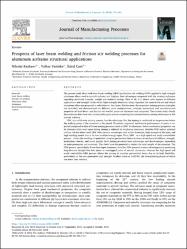| dc.contributor.author | Kashaev, Nikolai | |
| dc.contributor.author | Ventzke, Volker | |
| dc.contributor.author | Çam, Gürel | |
| dc.date.accessioned | 12.07.201910:50:10 | |
| dc.date.accessioned | 2019-07-12T22:06:00Z | |
| dc.date.available | 12.07.201910:50:10 | |
| dc.date.available | 2019-07-12T22:06:00Z | |
| dc.date.issued | 2018 | |
| dc.identifier.citation | Kashaev, N., Ventzke, V., Cam, G. (2018). Prospects of laser beam welding and friction stir welding processes for aluminum airframe structural applications. Journal of Manufacturing Processes, 36, 571-600. doi: 10.1016/j.jmapro.2018.10.005 | en_US |
| dc.identifier.issn | 1526-6125 | |
| dc.identifier.uri | https://doi.org/10.1016/j.jmapro.2018.10.005 | |
| dc.identifier.uri | https://hdl.handle.net/20.500.12508/613 | |
| dc.description | WOS: 000454468100058 | en_US |
| dc.description | Science Citation Index Expanded | en_US |
| dc.description.abstract | The present study deals with laser beam welding (LBW) and friction stir welding (FSW) applied to high-strength aluminum alloys used in aircraft industry and displays their advantages compared with the riveting technique regarding structural integrity, weight and material savings. First of all, it is shown with respect to different applications and strength levels which high-strength aluminum alloys represent the state-of-the-art and which aluminum alloys are proposed as substitutes in the future. Furthermore, the respective joining process principles are described and demonstrated on different joint configurations, whereby mechanical and microstructural properties of laser beam- and friction-stir-welded joints are discussed and compared. The current study clearly demonstrates that these two joining techniques are not competing but complementary joining techniques in the aircraft industry. FSW, as a solid-state joining process, has the advantage that the joining is conducted at temperatures below the melting point of the materials to be joined. Therefore, improved mechanical performance of joints is expected compared to that of fusion joining processes such as LBW. Furthermore, better mechanical properties can be obtained when heat input during joining is reduced by employing stationary shoulder FSW and/or external cooling. On the other hand, LBW offers several advantages such as low distortion, high strength of the joint, and high welding speeds due to its low localized-energy input. Thus, LBW - as a high-speed and easily controllable process - allows the welding of optimized complex geometrical forms in terms of mechanical stiffness, strength, production velocity, and visual quality. Both joining processes have advantages and disadvantages, depending on joint geometries and materials. They both have the potential to reduce the total weight of the structure. The FSW process (particularly lower heat input stationary shoulder FSW process) is more advantageous in producing long-distance straight-line butt joints or overlapped joints of aircraft structures, whereas the high-speed and easily controllable LBW process allows the joining of complex geometrical forms due to its high flexibility, particularly in the new generation high strength Al-alloys (such as AA2198), the strengthening phases of which are more heat resistant. | en_US |
| dc.language.iso | eng | en_US |
| dc.publisher | Elsevier Ltd | en_US |
| dc.relation.isversionof | 10.1016/j.jmapro.2018.10.005 | en_US |
| dc.rights | info:eu-repo/semantics/openAccess | en_US |
| dc.subject | Laser Beam Welding | en_US |
| dc.subject | Friction Stir Welding | en_US |
| dc.subject | Aluminum Alloys | en_US |
| dc.subject | Aerospace | en_US |
| dc.subject | Structural Performance | en_US |
| dc.subject | T-Joints | en_US |
| dc.subject.classification | Engineering | Manufacturing | en_US |
| dc.subject.classification | Friction stir welding | Research laboratories | Tool pin | en_US |
| dc.subject.other | fatigue-crack-growth | en_US |
| dc.subject.other | al-mg-si | en_US |
| dc.subject.other | welded t-joints | en_US |
| dc.subject.other | mechanical-properties | en_US |
| dc.subject.other | tensile properties | en_US |
| dc.subject.other | temper condition | en_US |
| dc.subject.other | heat-treatment | en_US |
| dc.subject.other | residual-stress | en_US |
| dc.subject.other | butt-joints | en_US |
| dc.subject.other | microstructural characteristics | en_US |
| dc.subject.other | aircraft | en_US |
| dc.subject.other | aircraft manufacture | en_US |
| dc.subject.other | airframes | en_US |
| dc.subject.other | aluminum alloys | en_US |
| dc.subject.other | friction | en_US |
| dc.subject.other | geometry | en_US |
| dc.subject.other | high strength alloys | en_US |
| dc.subject.other | joining | en_US |
| dc.subject.other | laser beam welding | en_US |
| dc.subject.other | laser beams | en_US |
| dc.subject.other | mechanical properties | en_US |
| dc.subject.other | research laboratories | en_US |
| dc.subject.other | aerospace | en_US |
| dc.subject.other | friction stir welded joints | en_US |
| dc.subject.other | friction stir welding(FSW) | en_US |
| dc.subject.other | high strength aluminum alloys | en_US |
| dc.subject.other | laser beam welding (LBW) | en_US |
| dc.subject.other | micro-structural properties | en_US |
| dc.subject.other | structural performance | en_US |
| dc.subject.other | t joints | en_US |
| dc.subject.other | friction stir welding | en_US |
| dc.title | Prospects of laser beam welding and friction stir welding processes for aluminum airframe structural applications | en_US |
| dc.type | review | en_US |
| dc.relation.journal | Journal of Manufacturing Processes | en_US |
| dc.contributor.department | Mühendislik ve Doğa Bilimleri Fakültesi | en_US |
| dc.identifier.volume | 36 | en_US |
| dc.identifier.startpage | 571 | en_US |
| dc.identifier.endpage | 600 | en_US |
| dc.relation.publicationcategory | Diğer | en_US |
| dc.contributor.isteauthor | Çam, Gürel | |
| dc.relation.index | Web of Science (ESCI) - Scopus | en_US |
















